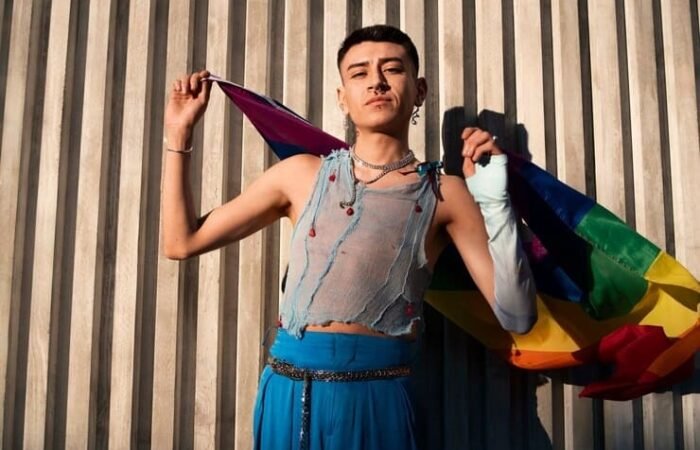In the ever-evolving landscape of fashion, a revolution is unfolding. A revolution that challenges traditional gender norms and embraces individuality, self-expression, and inclusivity. This revolution is the rise of gender-neutral fashion, a movement that transcends the confines of binary gender identities and celebrates the diversity of human expression.
“Fashion is not something that exists in dresses only. Fashion is in the sky, in the street, fashion has to do with ideas, the way we live, what is happening.” – Coco Chanel
Thesis: The evolution of gender-neutral fashion is a pivotal moment in the fashion industry, reflecting societal progress towards greater acceptance of diverse gender identities and empowering individuals to express themselves authentically without the constraints of traditional gender norms.
Overview
The Concept of Gender-Neutral Fashion
Gender-neutral fashion, also known as unisex or genderless fashion, is a style that transcends the traditional binary divisions of men’s and women’s clothing. It embraces a fluid and inclusive approach, rejecting the notion that certain garments or styles should be reserved for specific genders. This concept challenges societal norms and encourages individuals to embrace their authentic selves, regardless of their gender identity or expression.
The importance of breaking traditional gender norms in the fashion industry cannot be overstated. Fashion has long been a powerful medium for self-expression, and the emergence of gender-neutral clothing is a testament to the industry’s growing recognition of diversity and inclusivity. It represents a shift towards a more equitable and progressive landscape, where individuals are celebrated for their uniqueness, rather than confined by rigid gender expectations.
In recent years, the popularity and acceptance of gender-neutral fashion have soared, with an increasing number of designers, brands, and consumers embracing this inclusive approach. This evolution not only reflects changing societal attitudes but also highlights the fashion industry’s ability to drive positive change and challenge outdated norms.
The History of Gendered Fashion
The Origins of Gender-Specific Clothing
Throughout history, societal norms have played a significant role in shaping fashion choices and dictating what is considered appropriate or acceptable for different genders. The concept of gender-specific clothing can be traced back to ancient civilizations, where clothing was often used to reinforce gender roles and social hierarchies.
In medieval Europe, for example, men’s clothing was designed to symbolize power, strength, and authority, while women’s attire emphasized modesty, femininity, and domestic roles. This division of clothing along gender lines was further reinforced during the Victorian era, where strict dress codes and rigid social norms governed fashion choices.
Challenging Traditional Gender Roles in Fashion
While gender-specific clothing was deeply entrenched in various cultures and societies, there have been numerous instances throughout history where individuals challenged these norms and pushed the boundaries of gender expression through fashion.
One notable example is the Bloomers movement in the 19th century, where women advocated for more practical and comfortable clothing, rejecting the restrictive corsets and voluminous skirts of the time. This movement, led by Amelia Bloomer, was not only a fashion statement but also a symbol of women’s empowerment and a challenge to prevailing gender roles.
In the 20th century, the rise of counterculture movements, such as the hippie and punk subcultures, further challenged traditional gender norms in fashion. These movements embraced androgynous and gender-fluid styles, rejecting societal expectations and celebrating individuality and self-expression.
The Rise of Gender-Neutral Fashion
Embracing Inclusivity and Diversity
As society has evolved, so too has the fashion industry. In recent decades, there has been a growing recognition and celebration of diversity, inclusivity, and the need to break free from rigid gender norms. This shift has been driven by a combination of factors, including changing societal attitudes, increased awareness of gender and sexual identities, and a desire for authentic self-expression.
Designers and brands have responded to this cultural shift by embracing gender-neutral designs, challenging traditional notions of what constitutes “men’s” or “women’s” clothing. From unisex t-shirts and jeans to androgynous tailoring and fluid silhouettes, the boundaries between traditionally gendered clothing have become increasingly blurred.
“Gender-neutral fashion is not just a trend, it’s a movement towards equality and self-expression.” – Raf Simons, Fashion Designer
This movement towards gender-neutral fashion has been championed by a diverse range of influential figures, from designers and celebrities to activists and social influencers. Their advocacy has helped to normalize and mainstream gender-fluid styles, encouraging individuals to express themselves freely, without the constraints of binary gender norms.
Fashion Forward: Trends and Innovations
Current Trends in Gender-Neutral Fashion
The current landscape of gender-neutral fashion is vibrant and ever-evolving, with a multitude of trends and innovations that challenge traditional gender boundaries. From androgynous suiting and oversized silhouettes to gender-inclusive underwear and footwear, the possibilities for self-expression are limitless.
One prominent trend in gender-neutral fashion is the rise of unisex lines and capsule collections from both established and emerging designers. These collections offer a range of versatile and adaptable pieces that can be styled and worn by individuals of any gender identity or expression.
Another noteworthy trend is the increasing visibility of non-binary and gender-fluid models and influencers, who are challenging traditional beauty standards and advocating for greater representation and inclusivity in the fashion industry.
Innovative Designs Blurring Gender Boundaries
Designers and brands at the forefront of the gender-neutral fashion movement are continuously pushing the boundaries of innovation, creating garments that defy traditional gender norms and celebrate individuality.
One example of innovative gender-neutral design is the use of adjustable and adaptable silhouettes, allowing individuals to customize and personalize their clothing to suit their unique body shapes and gender expressions. Additionally, the incorporation of gender-neutral sizing systems and the elimination of gendered sizing labels have become increasingly common practices.
The impact of gender-neutral fashion on mainstream culture cannot be understated. As more individuals embrace this inclusive approach to fashion, it has the potential to reshape societal perceptions and challenge deeply ingrained gender stereotypes. By blurring the lines between traditionally gendered clothing, gender-neutral fashion promotes a more inclusive and accepting society, where individuals are celebrated for their authenticity and self-expression.
Breaking Barriers: Challenges and Progress
Challenges Faced by Gender-Neutral Fashion
Despite the growing popularity and acceptance of gender-neutral fashion, this movement has faced its fair share of challenges within the predominantly gendered fashion industry. One significant hurdle has been the deeply entrenched societal and cultural norms surrounding gender and clothing.
Breaking free from these ingrained norms has required a concerted effort from designers, brands, and advocates to challenge traditional perceptions and promote a more inclusive and fluid understanding of fashion.
Another challenge has been the practical considerations of producing and marketing gender-neutral clothing. From sizing and fit to marketing and merchandising strategies, the fashion industry has had to adapt and innovate to cater to this evolving market.
Progress in Promoting Inclusivity and Diversity
Despite these challenges, the fashion industry has made significant strides in promoting inclusivity and diversity through gender-neutral fashion. Major fashion houses and retailers have embraced this movement, introducing gender-neutral lines and collections, and championing the message of self-expression and body positivity.
Additionally, social media and digital platforms have played a crucial role in amplifying the voices of gender-neutral fashion advocates, influencers, and individuals who embrace this inclusive approach. These platforms have created a space for open dialogue, education, and community-building, further accelerating the acceptance and normalization of gender-fluid fashion.
Statistics from various market research firms and industry reports indicate a growing market for gender-neutral clothing, with sales figures and consumer demand steadily increasing year after year. This trend highlights the growing acceptance and mainstream appeal of this fashion movement.
The Future of Gender-Neutral Fashion
Predictions and Potential Impact
As the fashion industry continues to evolve and adapt to changing societal attitudes and consumer demands, the future of gender-neutral fashion appears promising. Many experts and industry insiders predict that this inclusive approach to fashion will become increasingly normalized and mainstream, transcending niche markets and subcultures.
The potential impact of gender-neutral fashion extends beyond the realm of clothing and style. By challenging traditional gender norms and promoting self-expression, this movement has the power to influence societal perceptions and attitudes towards gender and identity.
As more individuals embrace gender-neutral fashion, it could lead to a broader acceptance and celebration of diverse gender identities and expressions, fostering a more inclusive and equitable society.
Supporting and Participating in the Movement
For individuals who wish to support and participate in the gender-neutral fashion movement, there are various ways to get involved. Firstly, consciously supporting brands and designers that embrace inclusivity and promote gender-neutral fashion can help drive industry change.
Additionally, engaging with online communities, social media platforms, and influencers who advocate for gender-fluid fashion can help raise awareness and amplify the voices of those championing this movement.
Ultimately, the most powerful way to support gender-neutral fashion is to embrace it personally, by exploring and expressing oneself through clothing without the constraints of traditional gender norms. By breaking free from these societal expectations and embracing authenticity, individuals can contribute to the normalization and acceptance of gender-fluid fashion.
Conclusion
The evolution of gender-neutral fashion is a powerful and transformative movement that challenges long-standing societal norms and promotes inclusivity, diversity, and authentic self-expression. From its historical roots in challenging traditional gender roles to its current status as a mainstream and influential force, this fashion movement has reshaped the industry and societal perceptions of gender and identity.
By embracing gender-neutral fashion, individuals are not only expressing their personal style but also contributing to a broader cultural shift towards greater acceptance and celebration of diverse gender identities and expressions. This evolution represents a significant step towards a more equitable and inclusive society, where individuals are free to express themselves authentically, without the confines of binary gender norms.
As the fashion industry continues to innovate and push boundaries, the future of gender-neutral fashion remains bright, offering boundless opportunities for self-expression, creativity, and progress. We encourage readers to explore and support this evolving fashion movement, embracing the power of clothing to transcend traditional gender boundaries and celebrate the rich diversity of human identity.








No Comment! Be the first one.